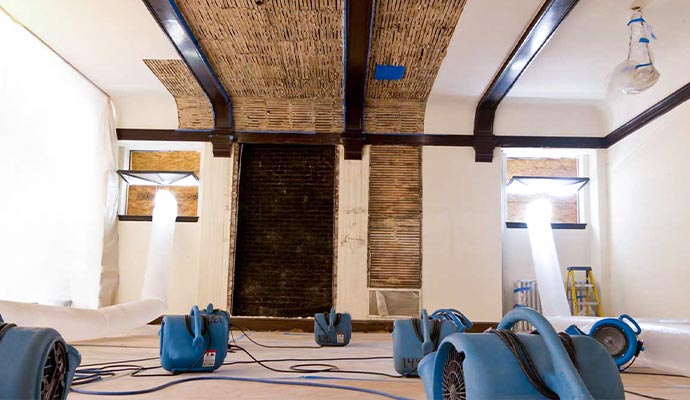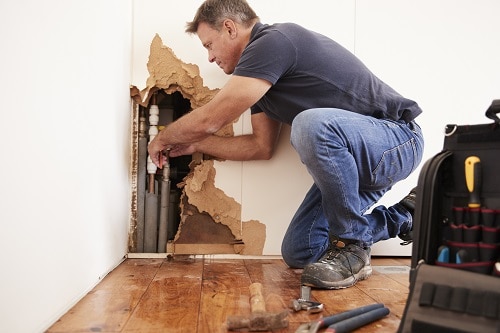Swift Water Damage Restoration Philadelphia: Your Trusted Recovery Partner
Wiki Article
Emergency Situation Water Damages Remediation: Swift Action to Decrease More Damages
What specifically does emergency situation water damage repair entail? By recognizing the seriousness and detailed nature of this process, you will acquire valuable insights into exactly how experts deal with emergency situation water damages, making certain a swift and effective response.Relevance of Swift Reaction
Swift response is of utmost value in water damage remediation to decrease additional damages and reduce prospective risks. The longer water sits in a building, the even more damage it can create.
One of the major reasons swift response is crucial in water damages reconstruction is to avoid the development of mold and mildew. Mold and mildew not just causes more damages to the framework of the structure yet also presents health dangers to occupants.
In addition, a punctual action can help salvage and bring back useful valuables and belongings - water damage restoration philadelphia. Water damages can be ravaging, specifically when it influences personal things of nostalgic or monetary worth. Performing swiftly enables experts to examine the damage and apply ideal reconstruction methods to recover as high as possible. This not just helps to reduce financial losses yet also brings tranquility of mind to those impacted.
Analyzing the Extent of Damages

Throughout the assessment, remediation professionals thoroughly examine the afflicted area to determine visible indicators of damages, such as water spots, distorted products, and mold growth. They likewise make use of specific devices to find concealed damage, such as wetness meters and thermal imaging cams. This extensive analysis enables them to precisely determine the extent of the damages and develop a tailored restoration plan.
Since it assists professionals prioritize their initiatives,Evaluating the level of water damage is vital. They can recognize locations that require prompt interest, such as standing water elimination and drying out, to avoid additional damages and reduce the danger of mold development. They can also determine the locations that need repairs or substitute, making certain that no damages goes unnoticed or unattended.

Water Extraction and Drying Refine
The water extraction and drying out procedure is a critical action in water damage reconstruction, as it involves the removal of excess water and the extensive drying out of the damaged area to avoid more damage and reduce the threat of mold development. After evaluating the level of the water damages, the following step is to remove the water from the afflicted location. This is commonly done making use of specialized tools such as dehumidifiers, pumps, and vacuum cleaners. These tools are made to effectively and efficiently eliminate water from numerous surface areas, including floorings, carpetings, and wall surfaces.This action is essential in protecting against additional damage, such as structural damage and the development of mold and mold. The drying procedure may take several days, depending on the extent of the water damage and the materials included.
It is necessary to ensure that the afflicted location is totally dry address before continuing with any fixings or basics reconstruction. Failure to completely dry the location can bring about long-term concerns, including damaged frameworks, moldy smells, and the growth of mold and mildew and mold. Consequently, professional water damage remediation firms employ wetness detection equipment to make certain that the afflicted area is totally dry before proceeding to the next step.
Mold Avoidance and Remediation
Effective mold prevention and remediation are essential in water damages reconstruction to make certain the security and stability of the affected location. mold remediation philadelphia. When water damage happens, whether from a burst pipeline, flooding, or a dripping roofing system, it creates an excellent environment for mold and mildew development. Mold and mildew can begin to create within 24 to two days after water damages, and if left unattended, it can spread quickly and trigger severe health threatsTo avoid mold and mildew growth, it is crucial to attend to water damage quickly. The very first step is to repair the resource and determine of the water invasion.
In situations where mold and mildew growth has actually currently occurred, remediation is required to remove the mold and mildew and avoid its return. This involves the cautious removal and disposal of damaged materials, such as drywall or carpet, to make sure that all traces of mold and mildew are eliminated. It is essential to note that mold removal need to be executed by experts who have the required training and tools to safely handle and get rid of mold and mildew.
Restoring the Affected Location

First of all, it is vital to extensively dry out the location to avoid any type of more damage and to inhibit the development of mold and mildew and mildew. This might involve using specialized drying equipment, such as dehumidifiers and industrial-grade from this source followers, to remove all wetness from the afflicted surfaces.
As soon as the location is entirely dry, the reconstruction process can begin. This might involve fixing or changing damaged structural components, such as flooring, ceiling, or drywall floor tiles. It is necessary to address any underlying concerns that may have created the water damages, such as dripping pipelines or malfunctioning pipes, to avoid future occurrences.
In addition, bring back the afflicted area may additionally consist of repainting walls, changing damaged fixtures, and extensively cleaning and disinfecting the space. This makes sure that not only is the location structurally sound, but it is additionally cosmetically pleasing and risk-free for occupancy.
Final Thought
In verdict, speedy response is critical in lessening additional damages triggered by water emergencies. Analyzing the extent of damages allows for efficient water removal and drying processes to be applied. In addition, mold and mildew avoidance and removal are important in restoring the affected location. Overall, timely action and complete repair steps are vital to mitigating the adverse influences of water damages.Swift feedback is of utmost value in water damage remediation to reduce additional damage and alleviate prospective risks.Throughout the analysis, restoration specialists thoroughly check out the afflicted area to determine visible indications of damage, such as water spots, distorted products, and mold development.The water extraction and drying out process is a crucial step in water damages restoration, as it includes the elimination of excess water and the complete drying of the affected area to avoid further damages and minimize the risk of mold development. After examining the extent of the water damages, the next action is to extract the water from the affected area.Reliable mold and mildew avoidance and remediation are crucial in water damages repair to ensure the safety and honesty of the affected area.
Report this wiki page